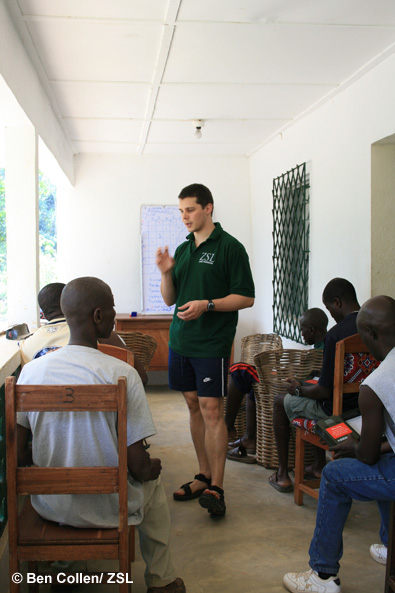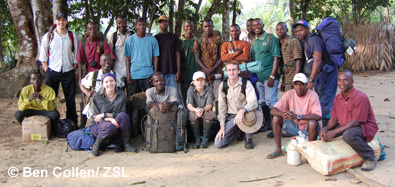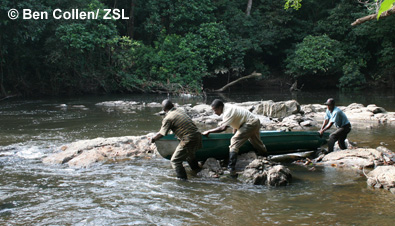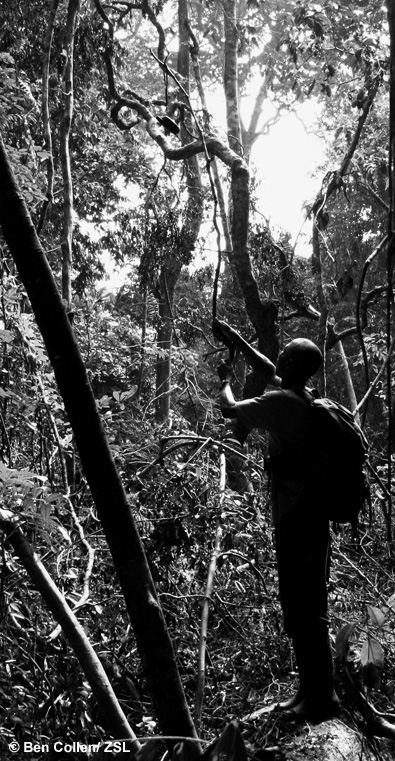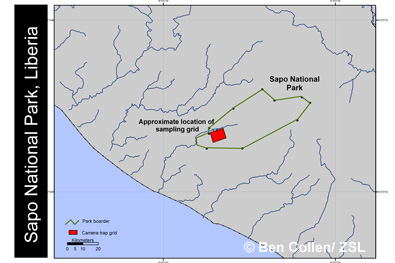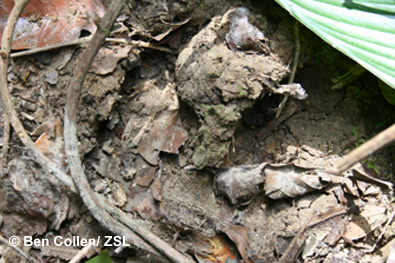Our first day in Sapo, we met up with Konie our EDGE fellow. While Konie is experienced at biomonitoring, camera trapping is a new skill for him, so we set about the training programme in remote monitoring using camera traps. The fundamentals of camera trapping operation, placement, maintenance, site selection and deployment were taught to a large group for FDA and FFI employees and University of Liberia students, along with GPS training.
Ben teaches camera programming to FDA
Testing the camera traps during training
Camera number 1 goes live
The team then prepared for the six day trip into the forest to establish the camera trap grid.
Top row: Ben Collen (ZSL – Project Leader), John Konie (FDA – Park Biologist), Blamah Goll (FDA – Chief Park Warden), Thomas Dogbeh (FDA – Auxiliary), Martin Borwlor (Porter), Moses Kolubah (FDA), Junior Nimley (FDA – Auxiliary), Melvin Chewlu (Porter), Zoryou Somah (FDA), Joshua Quawah (FDA – Research Officer), Burton Kawah (FDA – Community Engagement Ranger), John Smith (FDA – Zone Warden).
Bottom row: Jerome Farley (FDA – Auxiliary), Samuel Freeman (FDA – Zone Warden), Olivia Daniel (ZSL – Field Assistant), Jefferson Kannah (FDA – Ranger), Janna Rist (ZSL – Project Advisor), Robert Howard (FFI – Biomonitoring TA), Joshua Funnioh (FDA – Auxiliary), Junior Worjloh (FDA – Auxiliary).
Sapo is a challenging environment to implement a camera trapping monitoring scheme. The park border is a one hour walk, and a canoe ride away from park HQ.
Paddling up to the top end of the trapping grid
Some of the team encounter problems due to the lower water levels of the dry season
The grid of cameras we set out formed an 80 km2 area from the park border. There is no vehicle access, and very few pre-established trails. Therefore the majority of the time, the teams were cutting new trails into the park, and navigating by a combination of GPS, compass and the sun (when the satellite coverage failed and the compass was lost).
Unorthodox method of obtaining satellite signal on one of the GPS units
Each of the two teams were covering more than 20 km a day in order to establish the 32 cameras within the six day period. All did amazingly well, considering the majority of the group were new to the operation and deployment of camera traps and GPS navigation. The thickness of the forest really dictated our speed, with some frustrating days of only one camera being established.
At the end of the six days, the teams returned exhausted, but having successfully put out all the camera traps.
Tree frog in Hollywood pose
We had seen several signs (dung and footprints) of pygmy hippos during our time in the forest. Now all we had to do was wait…
Pygmy hippo print… honest.
